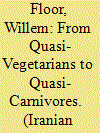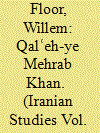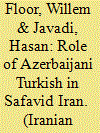|
|
|
Sort Order |
|
|
|
Items / Page
|
|
|
|
|
|
|
| Srl | Item |
| 1 |
ID:
180032


|
|
|
|
|
| Summary/Abstract |
Until the twentieth century there was little change in the diet of Iranians. Bread was the major staple, accompanied by vegetables, fruits, yoghurt, and nuts. Meat and rice were a luxury food for most consumers. In the nineteenth and twentieth centuries new food items were adopted by Persian consumers. After 1970, the modern Iranian diet—large amounts of white rice, meats, sugar-sweetened beverages and sweet/deserts, with few vegetables, herbs, nuts or fruits—has grown increasingly similar to the US diet, with the same health problems.
|
|
|
|
|
|
|
|
|
|
|
|
|
|
|
|
| 2 |
ID:
178771


|
|
|
|
|
| Summary/Abstract |
In February 1617, Jan Lucasz. van Hasselt arrived in Persia accompanying Pietro Della Valle (1586–1652), a Roman noble. Sometime between 1618 and 1621 Van Hasselt entered the service of Shah ʿAbbas I (r. 1588–1629), for whom he worked as a painter until the death of the shah. Later, during the reign of Shah Safi I (r. 1629–42) and until 1654 he tried to establish himself as a commercial agent for Persia. The present paper examines the career of this Dutch painter in Persia and the Netherlands. Meanwhile the artworks that may be attributed to him will be discussed.
|
|
|
|
|
|
|
|
|
|
|
|
|
|
|
|
| 3 |
ID:
171088


|
|
|
|
|
| Summary/Abstract |
Before discussing the establishment and functioning of the first real leprosarium in Iran, a brief explanation is given of the pathology of leprosy, the various names are listed under which it was known in Persian, and the earliest archeological evidence of its occurrence is presented. Also, societal behavior in Imperial Iran towards lepers is highlighted, while reference is made to the earliest medical descriptions of leprosy in Persian. Little is known about the occurrence of leprosy in Iran over the centuries, as evidenced by the lack of knowledge about its prevalence among medical practitioners and institutions in Iran, even as late as the 1920s. Although segregated villages with lepers existed prior to 1926, it was only as of then that the Mehrab Khan village became the first true Iranian leprosarium, when regular institutional medical treatment was offered by American missionary physicians. The funding agencies, medical personnel and treatment, the living environment of lepers and their numbers in Mehrab Khan are discussed as well as how its population size and status changed over time, and how it was transformed into a structural component of public medical care. Finally and briefly, the establishment and functioning of two other Iranian leprosaria is discussed as well as the slow but sure disappearance of the disease in Iran.
|
|
|
|
|
|
|
|
|
|
|
|
|
|
|
|
| 4 |
ID:
128569


|
|
|
|
|
| Publication |
2013.
|
| Summary/Abstract |
Turkic languages and dialects played a much more important role in Safavid Iran than is generally thought, while Azerbaijani Turkish in particular was widely spoken and written in Safavid Iran. It was not only the language of the court and the army, but it was also used in poetry, even by renowned poets who usually wrote in Persian. The Safavid shahs, many of whom wrote poetry in Turkish themselves, promoted its literary use. Also, Turkish was used in the court's official correspondence, for both internal and external affairs.
|
|
|
|
|
|
|
|
|
|
|
|
|
|
|
|
|
|
|
|
|